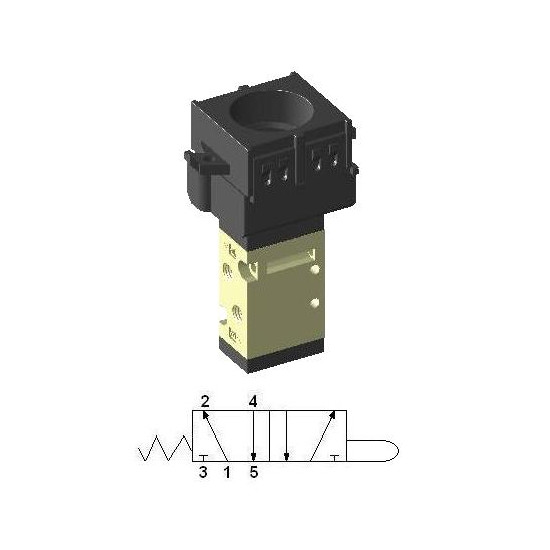Push Button Pneumatic Valves: Selection Guide for USA
What Are Push Button Pneumatic Valves and What Are They Used For?
In modern industry, manual control of pneumatic systems remains indispensable. Push button pneumatic valves are the ideal solution for direct actuation of compressed air circuits. These robust and reliable components allow operators to control airflow with a simple mechanical action, without depending on electrical power.
A push button pneumatic valve is a control device activated by pressing a button. Its function is to start, stop, or change the direction of air in a circuit. Unlike solenoid valves, their purely mechanical nature makes them perfect for environments where simplicity, electrical safety, or immediate manual control are priorities. They are typically constructed with an aluminum body and stainless steel internal components to ensure a long service life.
Key Advantages and Industrial Applications
These valves offer significant benefits for industry in the USA:
- Superior Reliability: Without electronic components, their mechanical robustness minimizes failures.
- Intrinsic Safety: Ideal for hazardous locations or humid environments as they generate no sparks, meeting stringent safety requirements common in US industrial facilities.
- Operational Simplicity: Direct control and instantaneous response without the need for programming.
- Low Cost: More economical in acquisition and maintenance than electropneumatic alternatives.
Common Applications in the USA
- Emergency stops: Mushroom-type push buttons for rapid depressurization, critical in automotive manufacturing plants across Michigan and other industrial states.
- Cylinder actuation: Manual control of ISO 15552 cylinders during adjustment or maintenance tasks in packaging facilities throughout the Midwest.
- Assembly stations: Activation of tools or pneumatic clamping systems in electronics manufacturing in California and Texas.
- Packaging machinery: Actuation of cutting, sealing, or ejection functions in food processing plants common in agricultural regions.
4 Key Criteria for Selecting the Right Valve
Choosing the right valve is crucial for performance and safety. Consider these four factors:
1. Circuit Function and Requirements
First, define your system's needs. To control a single-acting cylinder or a blow-off function, a 3/2 valve (3-way, 2-position) is sufficient. If you need to control a double-acting cylinder, which requires pressurizing two chambers alternately, you'll need a 5/2 valve (5-way, 2-position).
2. Working Pressure and Flow Rate
The valve must be compatible with your air network specifications.
- Working Pressure: Most valves operate in a range of 1 to 10 bar (14.5 to 145 psi), ideal for US industrial systems that typically work at 87-116 psi (6-8 bar). Never exceed the maximum specified pressure.
- Flow Rate (SCFM/l/min): Flow rate determines actuator response speed. For small compact cylinders, a flow rate of 7-14 SCFM (200-400 l/min) is adequate. For larger cylinders or high-speed applications, opt for valves with flow rates of 21 SCFM (600 l/min) or more.
3. Working Conditions and Materials
The operating environment dictates the materials needed to ensure durability.
- Temperature: The standard range is 14°F to 140°F (-10°C to +60°C), covering most applications. For more extreme environments, verify specifications for compliance with local conditions.
- Materials: Quality construction is fundamental. Look for an aluminum body for strength, NBR rubber seals for compatibility with air and oils, and a stainless steel spring for reliable return after millions of cycles.
- Connections: Ensure threads (typically G1/8" or G1/4", or NPT equivalents common in the USA) are compatible with your pneumatic fittings and tubing.
4. Mounting Type and Ergonomics
Operator safety and ease of use are paramount.
- Push Button Type: Choose a standard push button for general use. For emergency stops, opt for a mushroom-type push button, larger and more visible. In critical applications, consider push buttons with protection or locking to prevent accidental actuation.
- Mounting Type: Decide between individual in-line mounting, panel mounting for control consoles, or mounting on valve manifolds for modular systems.
Key Selection Points
- Define the function: 3/2 for single-acting, 5/2 for double-acting.
- Verify that system pressure does not exceed 145 psi (10 bar).
- Size flow rate according to actuator size and speed requirements.
- Choose push button type with safety and ergonomics in mind.
Installation and Maintenance Best Practices
To ensure a long service life, follow these recommendations:
Installation
- Depressurize the system before any intervention.
- Clean the piping to remove any debris or contaminants.
- Use PTFE tape or thread sealant on threads to ensure sealing, without over-tightening.
- Connect the ports (P: Pressure, A/B: Work, R/S: Exhaust) correctly according to ISO standards.
- Perform a leak test and functional test before final commissioning.
Maintenance
Maintenance is minimal but crucial. Always ensure air quality with FRL units (Filter-Regulator-Lubricator). Clean, dry air is the best guarantee of longevity and compliance with performance standards. Perform periodic visual inspections to detect leaks or damage and verify smooth push button operation.
Conclusion and Recommendations
Push button pneumatic valves are essential, reliable, and cost-effective components for manual control in industry. Their correct selection, based on circuit function, pressure, flow rate, and environmental conditions, is key to optimizing productivity and safety in US manufacturing operations.
Careful installation and maintenance focused on compressed air quality will guarantee exceptional performance for millions of cycles. At Pneumatig, we offer a wide range of high-quality valves and the technical expertise you need to find the perfect solution for your application in the USA.


Login and Registration Form